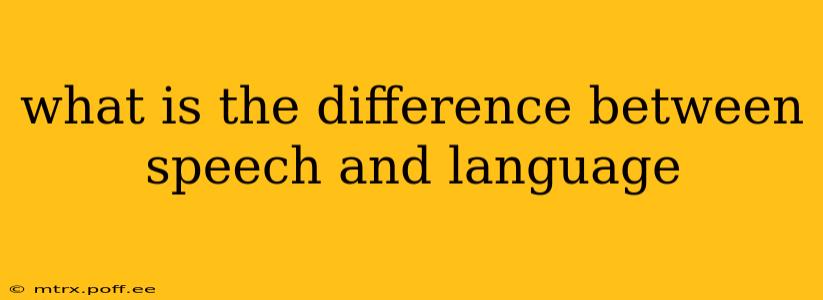What's the Difference Between Speech and Language?
The terms "speech" and "language" are often used interchangeably, but they represent distinct, though interconnected, aspects of communication. Understanding the difference is crucial for anyone interested in linguistics, communication disorders, or child development. This article will delve into the core distinctions, answering common questions along the way.
Language: Language is a complex system of symbols (words, signs, gestures) that we use to convey meaning. It's a cognitive ability that allows us to represent our thoughts, ideas, and experiences. Language encompasses several key components:
- Phonology: The sound system of a language, including the rules for combining sounds to form words.
- Morphology: The study of word formation and the internal structure of words.
- Syntax: The rules governing the order of words in a sentence.
- Semantics: The meaning of words, phrases, and sentences.
- Pragmatics: How language is used in social contexts, including understanding intentions and interpreting nonverbal cues.
Speech: Speech is the oral expression of language. It's the physical act of producing sounds to communicate. Speech involves several intricate processes:
- Respiration: The breath support needed to produce sounds.
- Phonation: The vibration of the vocal folds in the larynx to create voice.
- Resonance: The modification of sound by the throat, mouth, and nasal cavities.
- Articulation: The precise movements of the tongue, lips, and jaw to produce individual speech sounds.
Think of it this way: language is the blueprint, and speech is the construction. You can have a language (like sign language) without speech, but you can't have speech without a language to express.
What are some examples of language without speech?
This is a great question that highlights the distinction. Sign languages, like American Sign Language (ASL) or British Sign Language (BSL), are fully developed languages with their own grammar, syntax, and vocabulary. They're used by deaf and hard-of-hearing individuals to communicate effectively without relying on spoken words. Written language is another example; it represents language visually, without requiring speech.
How does speech differ from written language?
While both are forms of expressing language, they have distinct differences. Speech is typically less formal, more spontaneous, and relies on intonation and body language for meaning. Written language, on the other hand, is more structured, allows for editing and revision, and often uses different vocabulary and sentence structures.
Can someone have a fully developed language system but have problems with speech?
Absolutely. Individuals with speech impediments, such as apraxia of speech or dysarthria, may struggle with the motor skills of speech production, even though their language comprehension and expression are intact. They might understand and formulate complex ideas but face difficulties articulating them clearly.
What are some common difficulties encountered in both speech and language?
Both speech and language development can be affected by various factors, leading to difficulties like:
- Speech sound disorders: Difficulty producing speech sounds correctly.
- Language comprehension difficulties: Struggling to understand spoken or written language.
- Expressive language disorders: Difficulty expressing thoughts and ideas through language.
- Fluency disorders (stuttering): Interruptions in the flow of speech.
- Social communication disorders (e.g., autism): Difficulty with social aspects of communication, including understanding nonverbal cues and engaging in conversations.
In summary, while intertwined, speech and language are distinct. Language is the underlying system of symbols and rules, while speech is the physical act of producing those symbols orally. Understanding this distinction is crucial for appreciating the complexities of human communication and diagnosing potential communication disorders.
